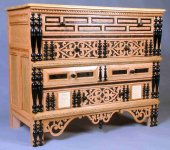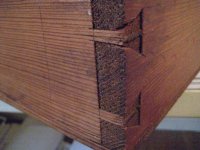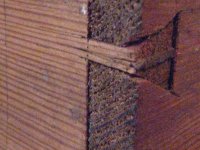Chests of drawers begin to appear in New England household inventories in the early 1640s…and certainly by the 1660s they are frequently found in Boston inventories. The carcasses are joined, i.e. stiles and rails joined with mortise-and-tenon joints, the sides and rear fitted with panels in the frames. The drawers are rabbeted & nailed in most instances; Boston ones usually employ half-blind dovetails to secure the sides to the fronts & backs. Further, these Boston examples often are two-case construction; containing four, sometimes five drawers. The best example is at Yale University, its lower case has three drawers behind doors, the upper case has two drawers – the uppermost is very shallow, the second drawer quite deep. Many of the Boston examples use imported timber.
Chests of drawers from outside Boston are also known, some are from Salem, others from an unknown shop in northern Essex County, Massachusetts. These chests of drawers are made in one case; and the drawers are rabbeted & nailed. These chests of drawers are made of riven oak, with secondary woods of pine, maple, walnut, etc.
If I did this right, attached is a chest of drawers I made based on some of the northern Essex County examples, c. 1670s-1680s.
Two old, but still relevant articles about early chests of drawers are both found in one volume of the Winterthur Portfolio:
Benno M. Forman, “The Chest of Drawers in America, 1635-1670: The Origins of the Joined Chest of Drawers,” Winterthur Portfolio 20, no. 1, (spring 1985): 1-30
Robert F. Trent, “The Chest of Drawers in America: A Postscript,” Winterthur Portfolio (spring 1985): 31-48
P Follansbee



